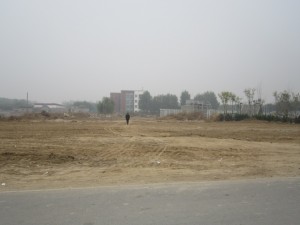Beijing's subway system growing rapidly, but unevenly

BEIJING -- Its a scene Zhang Haijie faces everyday. At seven thirty in the morning, a meters deep crowd has formed outside the entrance to Beijing’s Tiantongyuanbei subway station. Weary looking commuters jostle for position, while those with less patience jump over barriers designed to keep the commuters in line.
Haijie works in Beijing's city center, but lives in the far north of Beijing to save on rent, facing a ninety minute commute each day. “Because this is the first station on the line, people crowd here hoping they can get a seat for their trip to work,” he said.
Beijing has built 10 new subway lines in the past four years, bringing the city’s total number of lines to 14. Eight more are due to be completed in the next five years, at an estimated cost of 30 billion USD. By next year, Beijing's subway is set to become the world's second longest, trailing only Shanghai.
Tickets are cheap, at a flat rate of 2RMB ($0.3 USD) per trip, meaning that even Beijing's lowest paid migrant workers to afford a ride. The lines are operated by a government owned company, except for two which are run by Hong Kong’s MTR corporation via a joint venture with local Chinese firms.
The rapid speed of development provokes fears that Beijing is investing in more subway infrastructure than it needs. “In the last few years the requirements on cities wanting to build subway lines have been relaxed, and a lot of Chinese cities are building subways for no good reason,” Wang Mengshu, professor at the transport department of Beijing's Jiaotong University said.
Wang helped design Beijing’s first subway line in the 1960s. The line was military project designed to whisk senior Chinese politicians away from Beijing in the event of nuclear attack, and was not open for public use until the 1980s. But today Wang is a proponent of further subway expansion in the capital “Beijing still doesn’t have enough stations for a city of its size, that’s why there's so much road congestion,” he said.
Beijing’s residents are so desperate for subway lines to be built near their homes that they have organised committees to petition city planning authorities. Tiantonbeiyuan station was approved after a group of locals, led by a railway engineer, “bombarded” local government offices with phone calls requesting the addition of a station near their homes in 2005. Not all such campaigns have been equally successful. One group of residents in Southwest Beijing had their campaigning activities interrupted by the police, local media reported.
The scene at the terminal stop of one of Beijing’s newest lines is decidedly less busy. The Yizhuang line extends far beyond the city’s current residential areas, into farmland with bursts of new high-rise development, and the occasional factory. Outside the station, commuters are greeted by acres of empty land. A community of taxi drivers make a living ferrying a slow stream of commuters to nearby

villages. Four of Beijing’s newest lines extend out into similarly undeveloped areas.
Beijing is attracted to building subway lines in these empty parts of towns for two reasons, Wang said. First, because of the lack of physical obstacles, construction is faster and cheaper than in the inner city. But the main reason is that district governments can sell land to property developers for a higher price once a subway line is constructed on it. "It's a method the government uses to earn money" Wang said. “the district government wanted the Yizhuang line to boost its economy, and offered to pick up the bill.” At the tip of the line, the drivers are confident that the station will soon be bustling "Within two years, this place will be full of new apartment blocks," one driver said.
The rush to build new lines has created worries about safety. A teenage boy was killed and dozens were injured this July when an escalator installed in one of Beijing’s newest subway stations suddenly malfunctioned. Last month, 270 people were injured when two subway trains crashed in Shanghai, which has also seen rapid expansion in its subway system. “Lack of time for testing, and the failure of management to keep up with subway expansion are storing up problems for the future," a columnist on popular Chinese news portal Sina wrote.
On the platform of Tiantongbeiyuan, the subway car doors slide open, and a manic rush for seats ensues, leaving Haijie with standing room only. But he still stresses the advantages of Beijing's subway. “If you think this is crowded, you should take a look at the buses!” he said.
This post was originally published on Smartplanet.com
